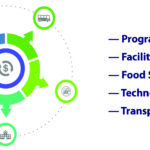In an era where the safety and well-being of students and staff are paramount, schools are increasingly turning to innovative technologies to transcend conventional security approaches. One such technology is Indoor GIS (Geographic Information System) mapping. This powerful tool allows schools to meticulously map their premises, identify key areas, emergency exits, and potential hazards, and create critical incident maps for effective emergency response.
Indoor GIS mapping is a technology that enables the creation of detailed, interactive maps of indoor spaces. Unlike traditional GIS, which focuses on outdoor environments, Indoor GIS provides a granular view of buildings’ interior layouts. This technology utilizes various data sources, including floor plans, building information models (BIM), and real-time location data, to create comprehensive maps that stakeholders can access and analyze.
A vital application of Indoor GIS mapping in schools is critical incident mapping. This involves creating detailed maps that can be used during emergencies to facilitate efficient navigation and coordinated responses. These maps highlight vital areas, emergency exits, and potential hazards, ensuring that emergency responders and school staff have accurate, up-to-date information to manage critical incidents effectively.
Benefits of Indoor GIS Mapping for Schools
Complementary to Facility Condition and Vulnerability Assessments
Indoor GIS mapping complements existing assessments by providing a visual and data-driven approach to understanding the physical environment. This enables schools to proactively foster safe and predictable learning environments. Schools can implement proactive safety protocols that minimize risks by identifying potential hazards and planning evacuation routes.
Enhanced Safety Preparedness
One of the most significant benefits of Indoor GIS mapping is its ability to enhance safety preparedness. By meticulously mapping the school’s premises, administrators can identify potential hazards and plan evacuation routes. This data can be shared with local emergency services, facilitating efficient navigation and coordinated responses in case of an emergency. Cultivating strong partnerships with local law enforcement and emergency responders ensures a quick and effective response during crises.
Optimized Facility Management
Indoor GIS mapping is also a powerful tool for optimizing facility management. Schools can efficiently allocate resources and plan maintenance schedules by providing a detailed view of the building’s layout. This optimization leads to improved operational efficiency and better utilization of available space. Schools can plan facility layouts more effectively, ensuring that spaces are used to their full potential.
Stakeholder Engagement and Transparency
Engaging with stakeholders is crucial for building trust and collaboration. Indoor GIS mapping allows schools to demonstrate transparency in their safety planning efforts. Schools can foster a sense of community and collaboration by involving parents, local businesses, and civic organizations in the planning process. This engagement helps build trust and ensures all parties are on the same page regarding safety protocols and procedures.
Budget Optimization
Effective resource utilization is essential for schools, especially when budgets are tight. Indoor GIS mapping aids in strategic planning and efficient resource allocation. Schools can make cost-effective long-term investments by optimizing facility management and safety planning. This ensures that resources are used wisely, and financial planning is aligned with the school’s safety and operational goals.
In conclusion, Indoor GIS mapping is a transformative technology that offers numerous benefits for schools. This technology enhances safety preparedness, optimizes facility management, and fosters stakeholder engagement by providing a detailed, data-driven view of indoor spaces. Superintendents who adopt Indoor GIS mapping can proactively ensure the well-being of their students and staff, creating a safer, more efficient, and collaborative learning environment. As schools continue to evolve and adapt to new challenges, Indoor GIS mapping and critical incident mapping will undoubtedly play a crucial role in shaping the future of educational safety and management.










